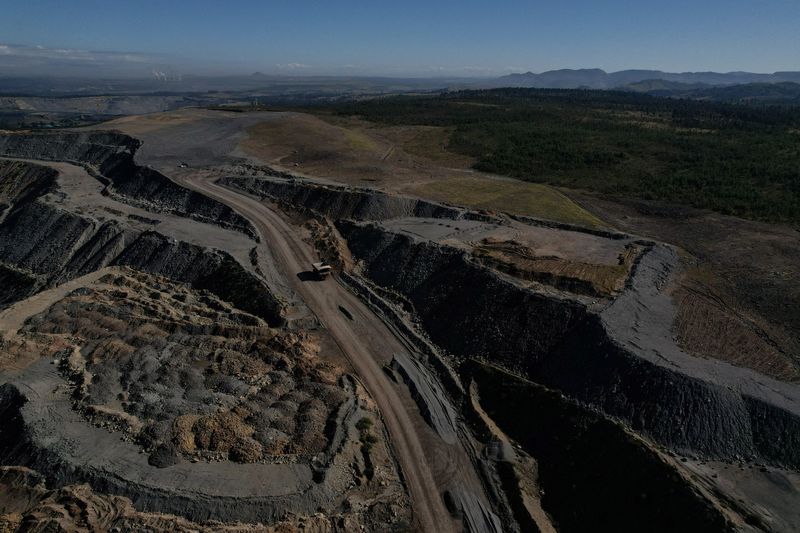By Praveen Menon
HUNTER VALLEY, Australia (Reuters) - At Glencore (LON:GLEN)'s aging Mt Owen open-cut coal mines north of Sydney, a team of scientists and engineers is restoring woodlands to mined-out fields, aiming to burnish the company's environmental credentials with climate activists and shareholders who want it to back away from coal.
But just hundreds of metres away, active mines still churn out nearly 7 million tonnes of coal a year, and are due to keep producing for 15 more years, as they fuel the company's profits from surging coal prices.
Keen both to maximise profit and to satisfy activist shareholders demanding action on the climate, Glencore has said it plans to hit net-zero carbon emissions by 2050 and "responsibly deplete its coal assets over time".
It has also invested in the rehabilitation of coal operations across Australia, spending A$43 million ($30 million) in 2020.
"Glencore is still mining coal, which is a huge contributor to climate change ... and trying to convince people that they are doing it better than they used to," said Gavin Mudd, an associate professor for environmental engineering at RMIT University in Melbourne.
"But it's not doing anywhere nearly enough to make the transition out of coal."
At the Mt Owen operation 140 miles (225 km) north of Sydney, acquired in 1998 as one of Glencore's first mining investments in Australia, about 1,600 hectares have been rehabilitated, or about half the land that was disrupted for mining activity, the company said.
"Our entire workforce ... are members of the local community and they want to leave something that provides a platform for high quality and productive post-mining land uses for future generations," Jason Desmond, the Environment & Community Manager at Glencore's Mt Owen Glendell Complex, told Reuters in a visit to the mine earlier this month.
A team of about 500 people will oversee the return of large swathes of coal mines to forest habitat, the company has said.
Glencore is Australia's largest coal producer with 17 active mining operations that last year produced 100 million tonnes of thermal coal, used to generate electricity, and coking coal, used to make steel. Almost all of it is exported.
Glencore forecast profits for its trading division to exceed $3.2 billion in the first half of this year, boosted by soaring prices that are due in large part to supply disruptions caused by the Ukraine conflict.
TRANSITION FROM COAL
Not all shareholders are happy about the bonanza.
About 24% of investors voted against Glencore's climate progress report in April, citing slow results in scaling back coal production.
The world's biggest climate action investor group, Climate Action 100+ (CA100+), flagged to members in April its concern that Glencore's emissions targets and coal production were not consistent with the world's climate goal.
Rival Anglo-Australian miner Rio Tinto (LON:RIO) sold its last coal mines in 2018, becoming the first mining major to go coal-free, while BHP Group Ltd has also been trying to get out of coal.
RMIT University's Mudd also raised questions about rehabilitation projects.
Not enough coal mines have been turned off permanently, so the impact on ground water and ecology after the area is rehabilitated will take years to understand, he said. "The industry cannot claim with certainty and confidently that it can be done well," he said.
Pressure for environmental action has been building on corporations in Australia since a newly elected government threw its weight behind tackling climate change.
Former Prime Minister Scott Morrison, who once brandished a chunk of coal in parliament to show his support for the industry, was voted out in May and replaced by Anthony Albanese, who has committed to an ambitious emissions reduction target of 43% by 2030 under the Paris Agreement.
In Australia's Hunter region, which houses Glencore's Mt Owen mine and has supplied coal for more than 200 years, local entrepreneurs are now among the leaders of the country's renewable energy transition.
"We started in 2015 when we saw a politician bringing coal into parliament and laughing about it," said Brian Craighead, Founder of Energy Renaissance, a privately held company that makes lithium-ion batteries for storage uses such as grid support for utilities and heavy-duty commercial vehicles.
"Every time we sell a product that means somebody's not burning fossil fuel," he said.
Green energy think tank Beyond Zero Emissions said renewable energy would support the region's diversification from coal.
"While we've got some of the best coal resources in the world, we also have the best sun and wind profiles in the world," said Heidi Lee, the think-tank's chief executive.
($1 = 1.4434 Australian dollars)
